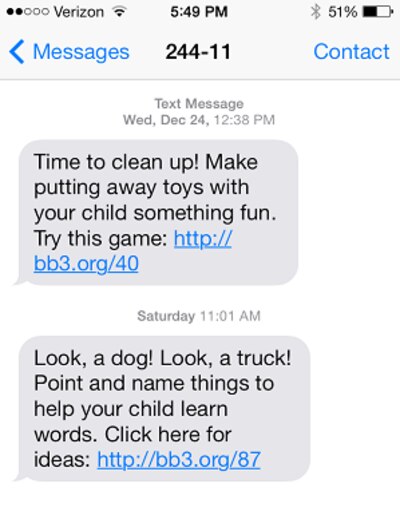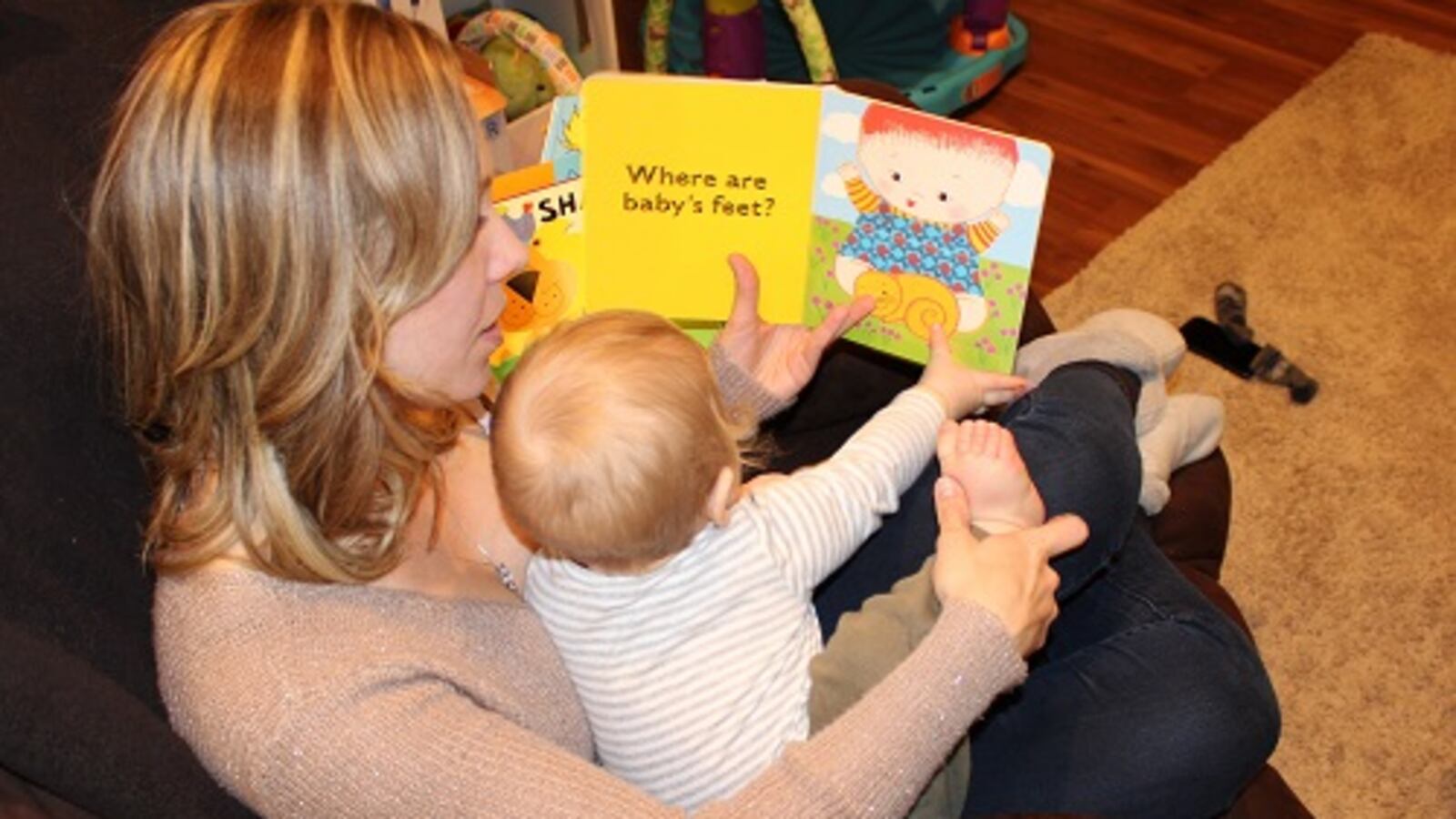Amy Dusin sometimes takes advantage of the quiet time when she nurses her seven-month-old son Hunter to review the parenting tips she got via text message that week. They remind her to play peekaboo with her baby or describe facial expressions to him when they look in the mirror together.
Dusin, who works part time as a convenience store manager in Greeley, said the texts provide nice reminders about learning activities.
After one recent text, she thought to herself, “Oh man, I really haven’t been playing peekaboo with him, I have to step my game up.”
The weekly text messages come from Bright by Three—formerly Colorado Bright Beginnings– a Denver-based non-profit that provides language and literacy resources to parents of children ages 0-3. The BrightByText initiative, which launched November 10, is part of the organization’s effort to bring a new level of technological sophistication to its 20-year-old program. So far, 285 parents or caregivers have enrolled in BrightByText.
“I think that we are the only ones in the state doing this,” said Katharine Brenton, director of strategic initiatives for Bright by Three. “I think it could be really big for us.”
While advice from a cell phone may not have the warm, fuzzy factor of a one-on-one conversation, there’s evidence it works. Studies of text-messaging interventions—with goals ranging from college matriculation to boosting early reading skills, suggest that the practice can help break down complex tasks into manageable bite-sized steps.
A study released in November found that a text messaging program with advice for parents on building early literacy skills increased the number of home literacy activities parents did with their children, upped parental involvement at school, and led to literacy gains among preschoolers.
“We were pleased that our program worked,” said Benjamin N. York, one of the study’s authors. “We’re a little bit surprised that it worked as well as it did.”
While that study focused on parents of four-year-olds, not parents of younger children as BrightByText does, York believes text messaging interventions are broadly applicable, and if developed carefully can impact families with children of all ages.
“Texting is really fertile ground to communicate with parents,” he said.
Dusin has already recommended the program to a friend who recently gave birth.
“I think it’s a good tool for parents who are interested in helping give their children the best kind of head start,” she said. “If you want it, you use it. If not, you just ignore the text.”
Updating the model
Throughout its two-decade existence, Bright by Three has relied on direct contact with parents, distributing kits containing books and learning games at annual doctor visits or through home visits by community volunteers. Last year, about 24,000 parents were served this way.

The intervention is relatively cheap—about $165 per child over three years—but also low-intensity. At most, parents receive about an hour’s worth of in-person advice each year for three years.
From now on, BrightByText will be a component of the traditional visit-based program as well as a stand-alone offering available to any interested parent. Bright by Three leaders hope to sign up 3,000 stand-alone subscribers in 2015. The weekly texts, which are tailored to the child’s age in months, will allow the organization to “up the dosage” of its positive parenting messages, said Brenton.
It helps that ninety percent of adult Americans own cell phones and 58 percent own smartphones, according to 2014 data from the Pew Research Center. The numbers remain surprisingly high for low-income families, with 84 percent of adults with household incomes under $30,000 owning cell phones.
For recipients, text messages are just plain convenient—available at all hours on a device many people keep within arm’s reach.
Dusin, who participates in Bright by Three’s traditional home visiting program as well as BrightByText, said, “I wouldn’t say that the visit is inconvenient, but I had to have someone come to my house and she was there for an hour….With the text, I can read it when I have time.”
She said some texts affirm things she’s already doing with Hunter, but others suggest activities she never thought about. One recent message encouraged parents to help children understand that storybook pictures represent real things.
She started using the concept while reading, “Where is Baby’s Belly Button?” a lift-the-flap book about parts of the body.
“I’ll compare the pictures that we’re reading about to him,” she said. “I’ll grab his feet and say, ‘These are your feet’…I know he doesn’t get it yet, but the more you do with him, the more you interact…the better it is down the road.”
Careful crafting
Firing off text message tips sounds fairly simple, but experts caution that such programs must be developed thoughtfully.
York, who’s planning further research on texting interventions, said his team put lots of time into developing and sequencing the content, and determining the thrice-weekly dosage.
“One of our concerns to be quite candid…is that organizations will just start texting parents in a more casual way not having gone through a process like we went through,” he said. “The devil is in the details.”
While text messaging programs for parents are not exactly common, one national program is Text4Baby, sponsored by the Johnson & Johnson company. The focus however is mostly on health topics, not early learning.
In the case of BrightByText, messages are based on the well-respected “LearningGames: The Abecedarian Curriculum,” which is also used for Bright by Three’s printed parent kits. In addition to one- or two-sentence tips about singing, playing or reading with children, each text includes links to “landing pages” that provide more information about each activity.
Bright by Three officials hope to offer Spanish-language texts sometime this spring, and eventually links to 100 videos modeling the activities and resources such as local library story times. All that development will be resource-intensive at first, but once everything’s in place it’ll cost almost nothing to run, said Brenton.
She said the organization’s robust in-house data system will help determine whether text message outreach is making a difference.
“Over the last couple years, we’ve made database to measure every single interaction and engagement we have with parents…a system capable of looking at what moves the needle.”

